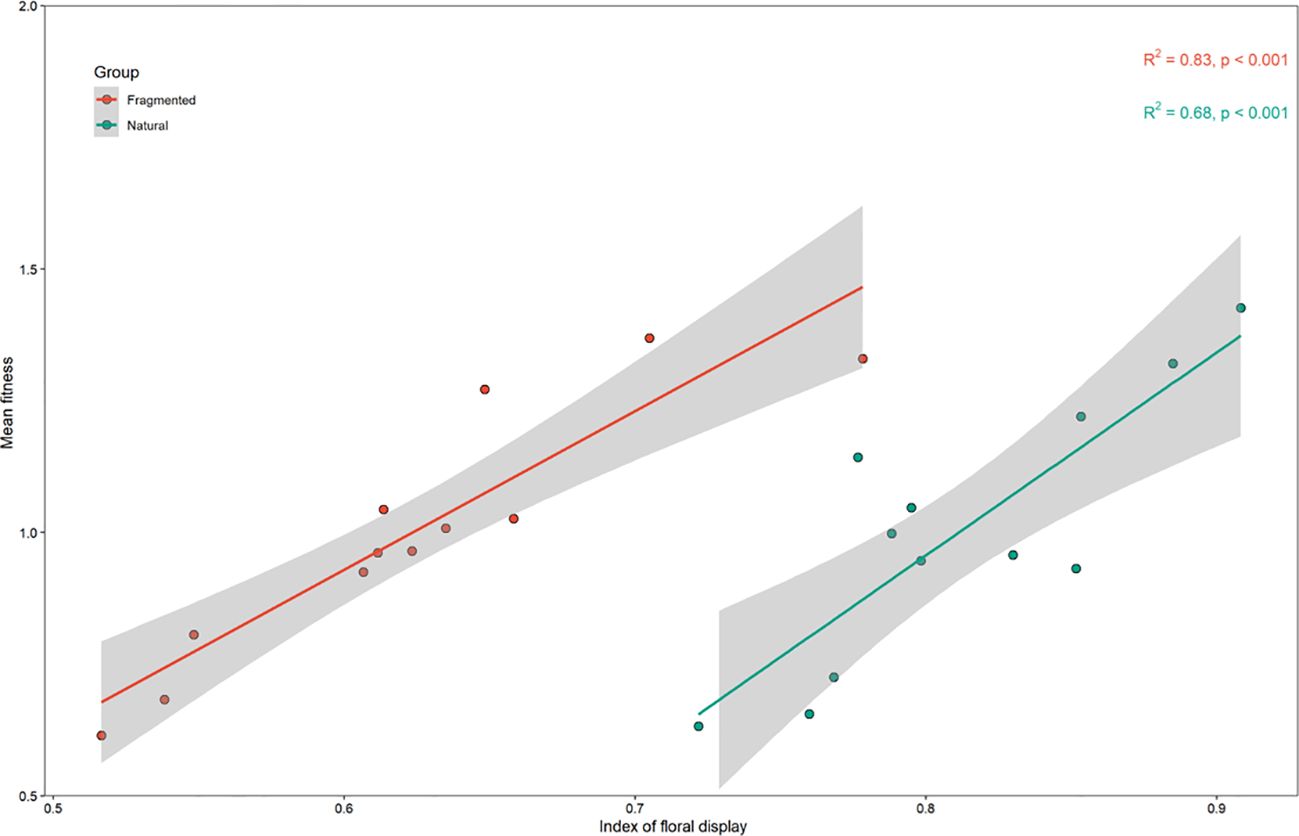- 1State Key Laboratory of Ecological Safety and Sustainable Development in Arid Lands, Northwest Institute of Eco-Environment and Resources, Chinese Academy of Sciences, Lanzhou, China
- 2Urat Desert-grassland Research Station, Northwest Institute of Eco-Environment and Resources, Chinese Academy of Sciences, Lanzhou, China
- 3Key Laboratory of Stress Physiology and Ecology in Cold and Arid Region of Gansu Province, Lanzhou, China
- 4University of Chinese Academy of Sciences, Beijing, China
- 5Naiman Desertification Research Station, Northwest Institute of Eco-Environment and Resources, Chinese Academy of Sciences, Lanzhou, China
Flowering shrubs in fragmented habitats often experience pollen limitation, which can lead to strong natural selection on floral display and affect reproductive success. Effective management and protection of dominant shrubs in fragmented habitats require a thorough understanding of the factors driving plant reproduction. However, the impact of fragmented habitats on reproductive success through floral display and pollinator visitation has not been experimentally quantified. We examined pollen limitation by comparing female fitness between open-pollinated and hand-pollinated plants. We also assessed the impact of natural selection (β) on floral display by comparing natural selection gradients in plants from natural and fragmented habitats. Our results show that this species is pollen-limited, with supplemental pollen increasing female fitness by 32%. This species exhibits directional selection for more open flowers and longer keel petals. We found that the number of open flowers is the main factor influencing pollinator visitation frequency and female fitness, and that pollinator visitation positively affects female fitness. This study provides insights into how fragmented habitats influence linear selection gradients related to the number of open flowers. Furthermore, this study highlights that fragmented habitats significantly influence reproductive success, with floral display being a crucial factor to consider when designing conservation strategies for this population.
Introduction
Habitat fragmentation is widely recognized as a major driver of biodiversity loss and the growing isolation of ecosystems (Newman et al., 2013). In evolutionary ecology, the floral display of plants influences reproductive success by affecting pollinator transfer efficiency. Habitat fragmentation can affect the plant flowering period and flower number, while human disturbance influences pollinator visitation. These factors result in variations in floral display that may ultimately impact pollination success (Zhong et al., 2019; Chen et al., 2022). Desert ecosystems typically feature sparse vegetation and are particularly sensitive to human disturbance (Villagra et al., 2009). Environmental changes can lead to variations in floral display (such as flower number and spatial arrangement) and pollinator activity (Chen et al., 2020). As human disturbance and environmental changes persist, alterations in habitat structure caused by degradation and desertification will diminish the reproductive success of many plant communities (Chen et al., 2022).
An insufficient supply of pollen can reduce pollination success and limit fecundity (Lennartsson, 2002; Knight et al., 2005). Pollen limitation refers to the insufficient quantity or quality of pollen transfer that impedes reproductive success (Gómez et al., 2010). Habitat fragmentation alters plant-pollinator mutualisms, as many flowering plants depend on pollinator services. The diversity and abundance of pollinators decrease in isolated habitats (Chen et al., 2020). Pollinator visitation can be limited by factors such as resource availability (e.g., rewards and the number of open flowers), which influence pollen transfer efficiency (Asikainen and Mutikainen, 2005). Inadequate pollen transfer is a key factor that limits pollinator visitation efficiency (Chen et al., 2022; Fernández et al., 2012). The quality and quantity of pollen that reaches the stigma are crucial factors influencing pollination success (Corbett, 2003; Harder and Aizen, 2010). There is substantial evidence of pollen limitation caused by insufficient pollinator visitation. Floral traits, particularly in flowering plants, show remarkable diversity in their impact on pollinator visitation efficiency (Ishii and Kadono, 2002).
Floral specialization plays a key role in plant-pollinator interactions, and the influence of natural selection on floral display warrants greater attention (Sletvold and Ågren, 2010). Floral display is positively correlated with pollinator visits, which in turn enhances female fitness (Sletvold et al., 2010; Sun et al., 2018). Pollen reception efficiency often influences natural selection on floral display and female reproductive success in many plant species (Knight et al., 2005; Ashman and Morgan, 2004). Pollinators are typically attracted to flowers with higher densities, as these flowers tend to offer more pollen and rewards (Ashman et al., 2004; Hadley and Betts, 2012). Additionally, pollinator visitation may decline in fragmented habitats, as environmental fragmentation and isolation can reduce pollinator foraging time and activity (Steffan-Dewenter et al., 2006). Pollinator-mediated selection for flower number may enhance pollination success (Sletvold and Ågren, 2010). A related study suggests that female reproductive success is positively correlated with plant height, flower number, and spur length in orchids (Gigord et al., 2001).
Caragana korshinskii Kom., a leguminous shrub, is a dominant species in desert steppe ecosystems, playing a crucial role in ecosystem stabilization and soil erosion prevention (Newman et al., 2013). As a nitrogen-fixing legume, it acts as a pioneer species for sand fixation in arid regions, enhancing soil fertility, promoting herbaceous vegetation growth, and bolstering ecosystem resilience (Yao et al., 2019). However, despite its ecological significance, C. korshinskii faces challenges related to habitat fragmentation and limited pollination, which may impact its long-term survival and regeneration. Predominantly pollinated by insects, the species’ reliance on biological pollination raises concerns about pollen limitation in fragmented habitats (Chen and Zhao, 2019). Given its ecological importance and dependence on pollinators, C. korshinskii serves as an ideal model for studying the effects of habitat fragmentation on pollen limitation in desert steppe ecosystems. However, studies directly quantifying the effect of natural selection on this species remain scarce, limiting the understanding of how floral display drives reproductive evolution in fragmented habitats. This study aimed to: 1) test the differences in pollen limitation intensity between open-pollinated and hand-pollinated plants, 2) quantify natural selection on floral display across different habitats, and 3) examine how fragmented habitats influence reproductive success via floral display, while comparing the relationships between pollinator visitation frequency and female fitness. Furthermore, this study provides strategies to improve reproductive success and conservation efforts for dominant shrub species.
Materials and methods
Study site
This study was conducted in the Urat desert steppe (106°59’-107°05’E, 41°06’-41°25’N, Figure 1), located in the western part of Inner Mongolia Province, northwestern China. The region experiences a mean annual precipitation of approximately 153.9 millimeters, with the majority of precipitation concentrated between May and September, characteristic of a temperate steppe climate (BSk, Köppen Climate Classification; Guo et al., 2022). In this region, Caragana korshinskii Kom is the dominant shrub species (Wang et al., 2022).
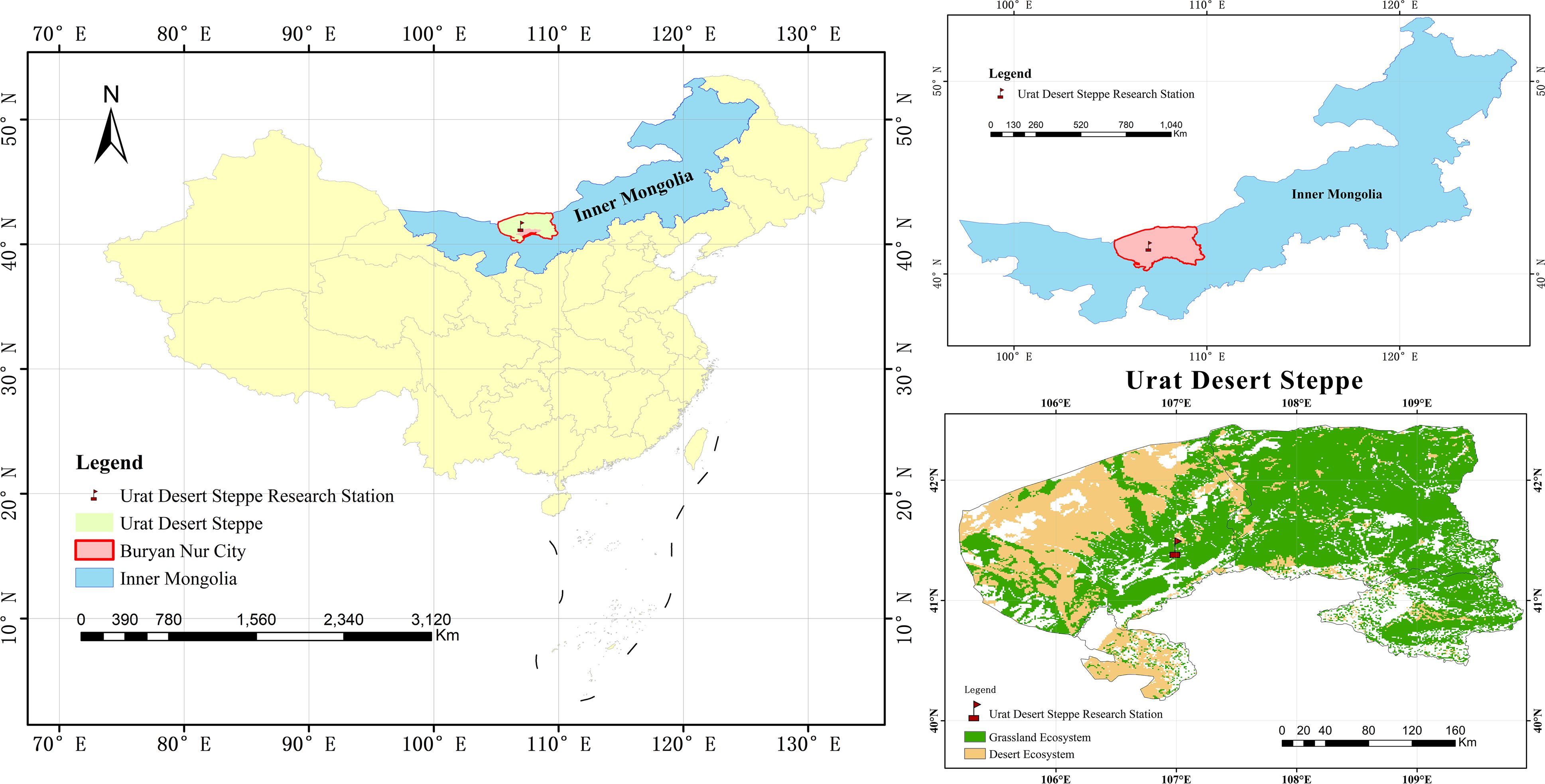
Figure 1. The study area is located in the Urat Desert steppe in Inner Mongolia Province, northwestern China.
Study species
C. korshinskii, a widespread leguminous shrub in desert grasslands, is a vital component of these ecosystems. It significantly contributes to soil stabilization, nitrogen fixation, and the formation of the vegetation structure. This species is distributed across Inner Mongolia and Ningxia provinces in northern China. The flowering period of C. korshinskii typically lasts from May to July, while the fruiting period extends from July to August. Furthermore, C. korshinskii, primarily an outbreeding species with partial self-compatibility, relies on pollinators for effective pollen transfer despite some self-fertilization capacity (Chen and Zuo, 2019).
Field experiment design
The experiment was conducted from May 2017 to September 2023. In 2017, age-matched C. korshinskii plants were selected for the study, with plant height standardized through regular cutting. Two experimental habitats were designed: 1) a natural habitat and 2) a fragmented habitat. Twelve plots were selected for each habitat, with habitats separated by 1 km to minimize pollinator interference. The fragmented habitat was located in a desert area with eroded topsoil. In the fragmented habitat, the twelve plots were distributed across cleared vegetated regions. The corresponding natural habitats were arranged similarly, with the same plant population (Figure 2). In 2023, experiments were conducted on floral display, natural selection, and pollinator visitation efficiency in both natural and fragmented habitats.
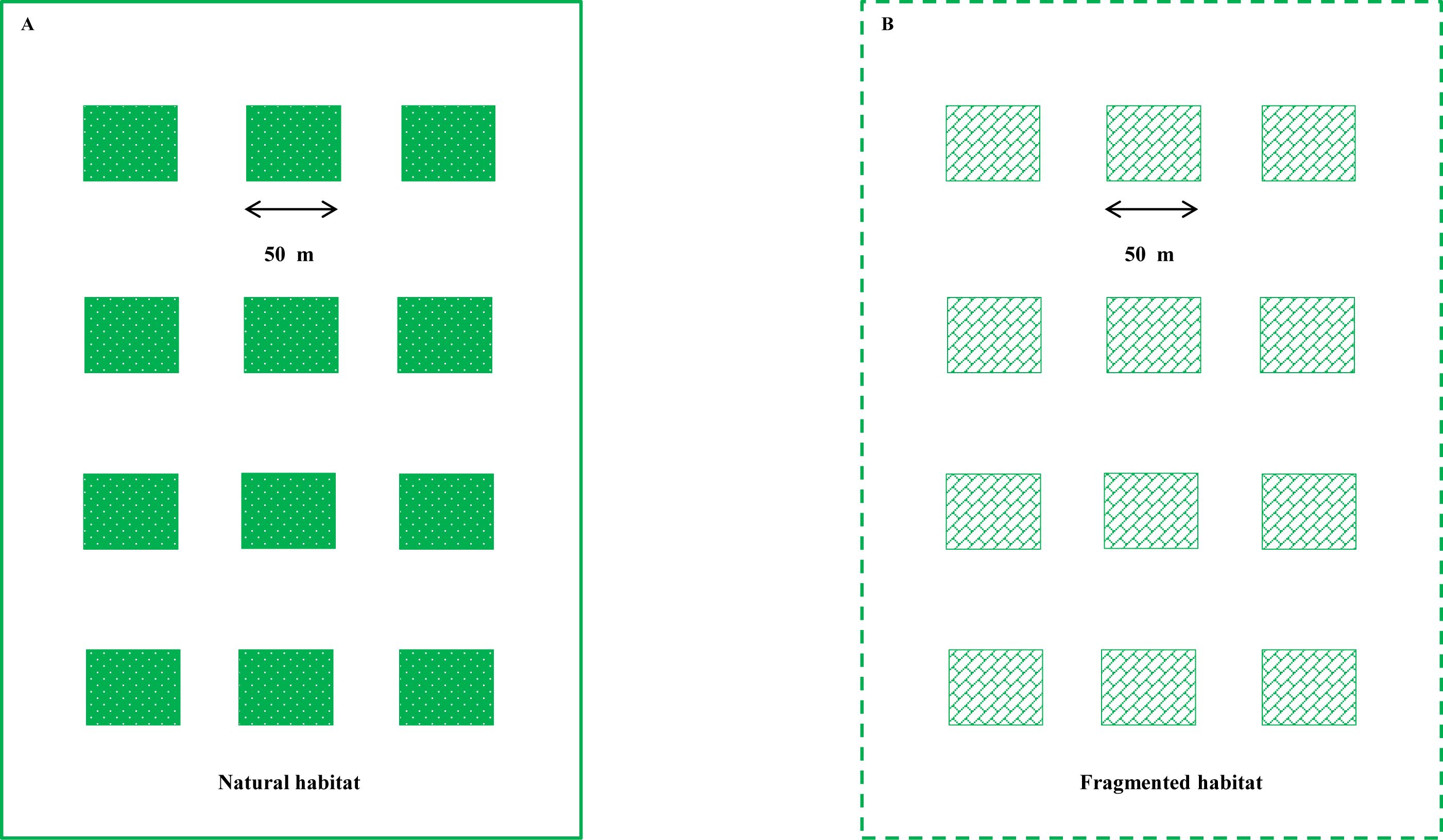
Figure 2. Experimental design for two treatments, natural habitat (A) and fragmented habitat (B), from 2017 to 2023. The 24 selected plots (50 m × 50 m) were separated by mown vegetation (white area).
Measured floral display
To assess floral display in both habitats, 144 plants with flowering buds were tagged across twelve natural and twelve fragmented plots (six plants per plot). In 2023, three inflorescences per tagged plant were marked, and digital calipers were used to measure keel petal length and corolla size (length and width) at the onset of flowering. In late May, tagged inflorescences with similar numbers of flower buds were selected. The number of open flowers was also recorded in June. Floral display indices of C. korshinskii were assessed as follows:
where IFD is the floral display index, I is the number of inflorescences, and AC is the area (m²) covered by plants in the natural and fragmented habitats. Seed production of the marked plants was evaluated during the seeding period, along with the relative female fitness of C. korshinskii in both habitats.
Quantified natural selection
We quantified the intensity of natural directional selection (β) by analyzing floral displays and estimating the selection gradients in both natural and fragmented habitats (Sletvold and Ågren, 2010). We also evaluated floral displays, including the number of open flowers, corolla size, and keel petal length, and compared the selection gradients (βN and βF) between natural and fragmented habitats.
Pollen limitation
In 2023, we tested whether C. korshinskii plants experience pollen limitation by measuring mean female fitness in both open-pollinated and hand-pollinated plants. In each plot, we tagged 18 inflorescences (six plants, three per plant) with flowering buds for both open- and hand-pollinated treatments. During the flowering period, we conducted supplemental hand pollinations, and all the tagged flowers received supplemental pollen from untagged individuals. In late September, we counted mature seeds and seed masses in the laboratory. We calculated an index of pollen limitation using the mean fitness (number of intact seeds × seed mass) of open-pollinated (MFC) and hand-pollinated (MFHP) plants in different habitats:
Positive values indicate greater mean fitness in the hand-pollinated (HP) treatment than in the open-pollinated (C) treatment, suggesting that C. korshinskii experiences pollen limitation. Negative or zero values indicate no pollen limitation.
Effect of pollinator visitation on female fitness in fragmented habitats
We assessed the relationship between pollinator visitation frequency and relative female fitness to determine whether visitation frequency influences female fitness (Gómez et al., 2010). We tagged 144 plants (six per plot) in both natural and fragmented habitats based on floral display measurements. During the flowering period (June–July), we marked the number of open flowers on each tagged inflorescence and selected three inflorescences per labeled plant. We observed the labeled plants for five days during the flowering period. To prevent self-pollination, we removed the stamens from selected flowers. We recorded pollinator behavior and visit duration for the tagged flowers using an HD camera from 08:00 to 18:00. We captured the dominant pollinator with an insect net and identified it to the species level. A microscope was used to check whether the pollinators carried pollen grains. To prevent pollen contamination, we euthanized the captured insects in numbered glass bottles, each containing a single insect. In September, we recorded the number of open flowers (OF), pollinator visitation frequency (VF), and measured relative female fitness (RFF; individual fitness divided by mean fitness) for the tagged flowers.
We compared the relationships between OF and VF and between VF and RFF to estimate how pollinator visitation affects female fitness (FF) in the visited flowers.
The pollinator visitation frequency is expressed as follows:
where NV is the number of pollinator visits to tagged plants and TP is the observation period (in days).
Statistical analysis
We used Analysis of Variance (ANOVA) to assess the impact of fragmented habitats on OP, corolla size, and keel petal length. We applied the same models to test the impact of floral display on female fitness. When significant effects were detected, we performed post-hoc tests using Fisher’s least significant difference. We then performed linear regressions to measure selection.
Relative female fitness was used as the response variable. Floral displays (standardized by Z score: OF, corolla size, and keel petal length) were used as explanatory variables. Additionally, we quantified mean female fitness (number of seeds × seed mass) and calculated the standardized values for each floral display.
Initially, we evaluated female fitness and standardized floral displays in each habitat, incorporating quadratic terms (γii) to quantify nonlinear selection. However, quadratic gradients were statistically insignificant, so we report only linear gradients. We also assessed multicollinearity by inspecting variance inflation factors (VIFs) and found that the VIF for floral display was < 2.5, indicating that collinearity was not a significant issue.
The same models were applied to explore the relationships between OF and VF. Additionally, we conducted Spearman correlations. We performed linear regressions to assess the relationship between OP and VF. We also conducted linear regressions to explore the relationship between VF and FF in different habitats. Finally, we applied piecewise structural equation modeling (SEM) to examine the direct and indirect pathways through which floral displays (OF, corolla size, and keel petal length) and pollinator visitation frequency influence female fitness in fragmented habitats (Hu et al., 2024). Model adequacy was assessed using Fisher’s C statistic in the “piecewiseSEM” package (R4.3.2) (Lefcheck, 2016). All statistical analyses were conducted using RStudio (R Core Team, 2023.09.1).
ANCOVA was applied to test whether different habitats affect linear selection gradients. We used relative fitness as the dependent variable. Additionally, standardized floral displays, habitat type (natural vs. fragmented), and the interaction between floral display and habitat were used as independent variables. To examine the effect of fragmented habitats, we quantified the estimated selection gradient for each floral display in different habitats. The analyses were performed using SPSS 24.0.
Results
Floral display
The number of open flowers, corolla size, and keel petal length for C. korshinskii are shown in Table 1. Our results show that both habitats had similar corolla sizes and keel petal lengths, but the number of open flowers was significantly greater in the natural habitat than in the fragmented habitat (P < 0.05; Table 1). Female fitness was significantly correlated with the floral display index (R² = 0.68, Natural; R² = 0.82, Fragmented; Figure 3). Plants with a higher floral display index had greater seed production and seed mass.
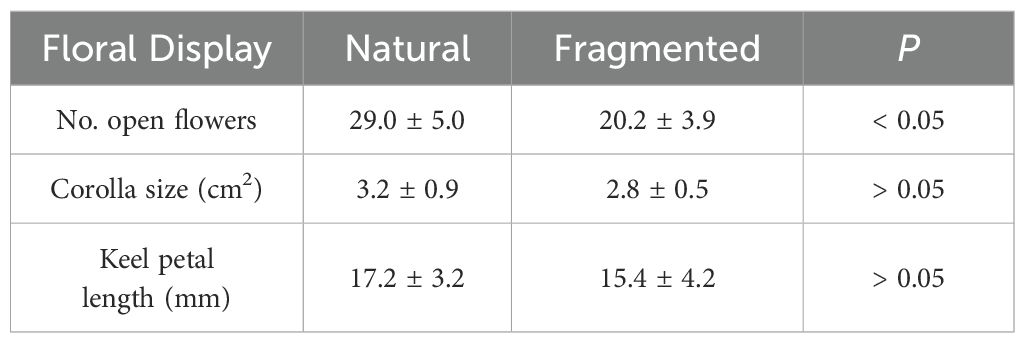
Table 1. Floral display (Mean ± SD) for natural plants (N) and fragmented plants (F) in the C. korshinskii.
Pollen limitation
Female fitness was significantly higher in hand-pollinated plants compared to open-pollinated plants in both habitats (P < 0.05; Table 2). Our results suggest that pollen supplementation significantly increased mean fitness in both natural and fragmented habitats (Figure 4). Additionally, supplemental pollen increased female fitness by 32%, and the index of pollen limitation (IPL) was 0.24 in the natural habitat. Our findings indicate that this species experiences severe pollen limitation. For open-pollinated plants, the mean fitness was 6.5 in the natural habitat and 4.6 in the fragmented habitat. Plants in the natural habitat had significantly higher mean female fitness than those in the fragmented habitat (Habitat effect, df = 1, P < 0.001; Table 3).

Table 2. Mean female fitness (Mean ± SD) for open-pollinated plants (C) and hand-pollinated plants (HP) in different habitats.
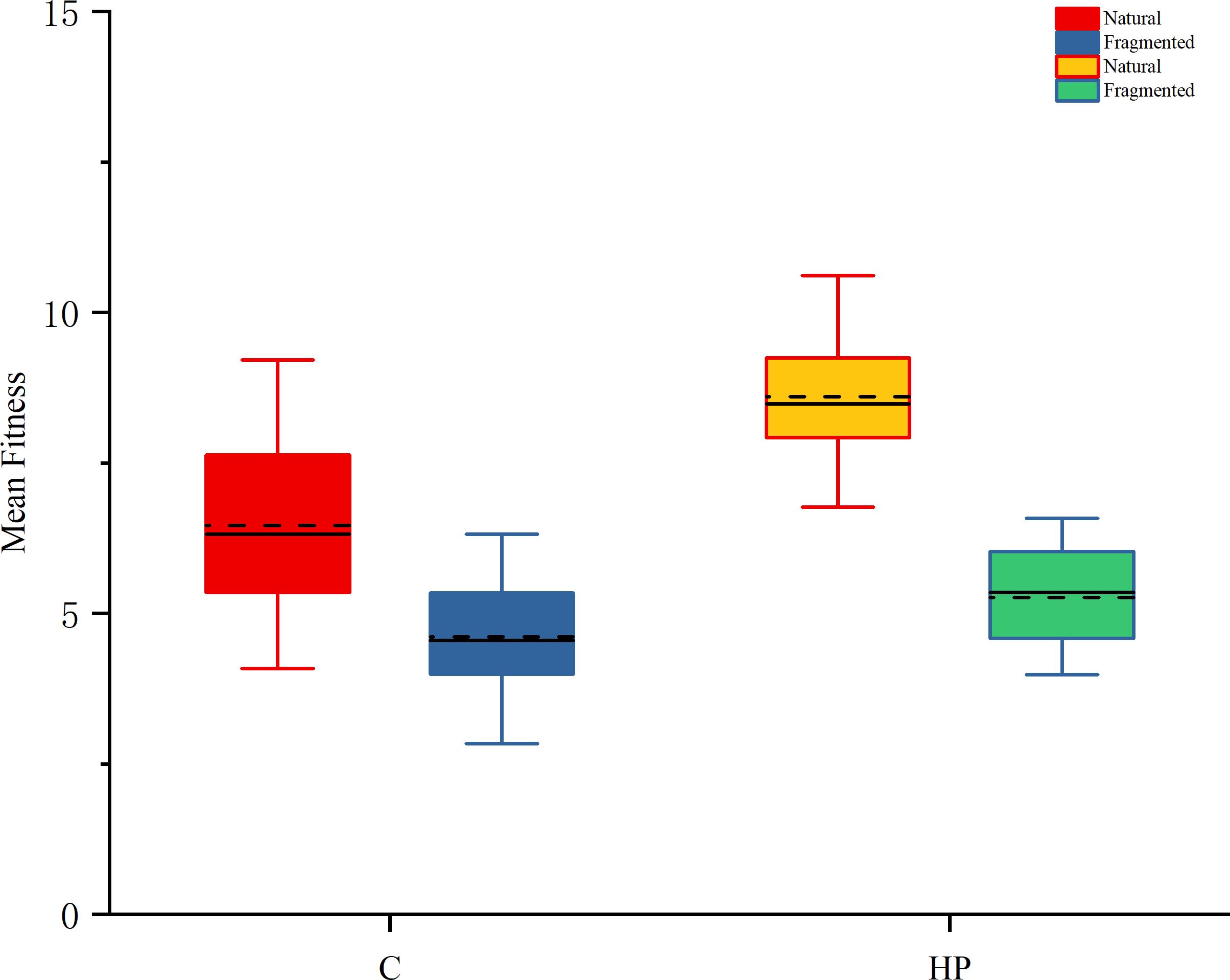
Figure 4. In natural and fragmented habitats, the mean fitness of C. korshinskii under different treatments (C and HP). C, open pollination treatment; HP, hand pollination treatment.
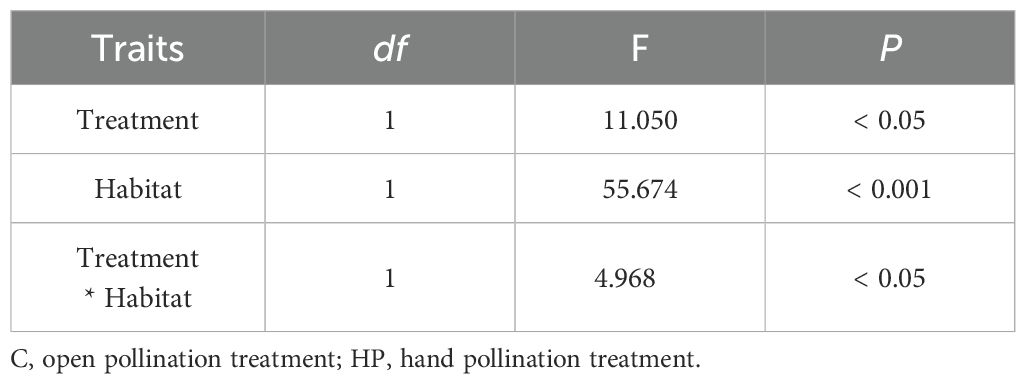
Table 3. Impact of treatments (C and HP) and different habitats (Natural and Fragmented) on mean female fitness of C. korshinskii.
Natural selection gradients for floral display
In C. korshinskii, directional selection favored plants with more open flowers and longer keel petals (Figure 5A, C). Additionally, corolla size was not significantly associated with selection (Figure 5B). Our findings suggest that the number of open flowers and keel petal length underwent significant positive directional selection (Table 4).
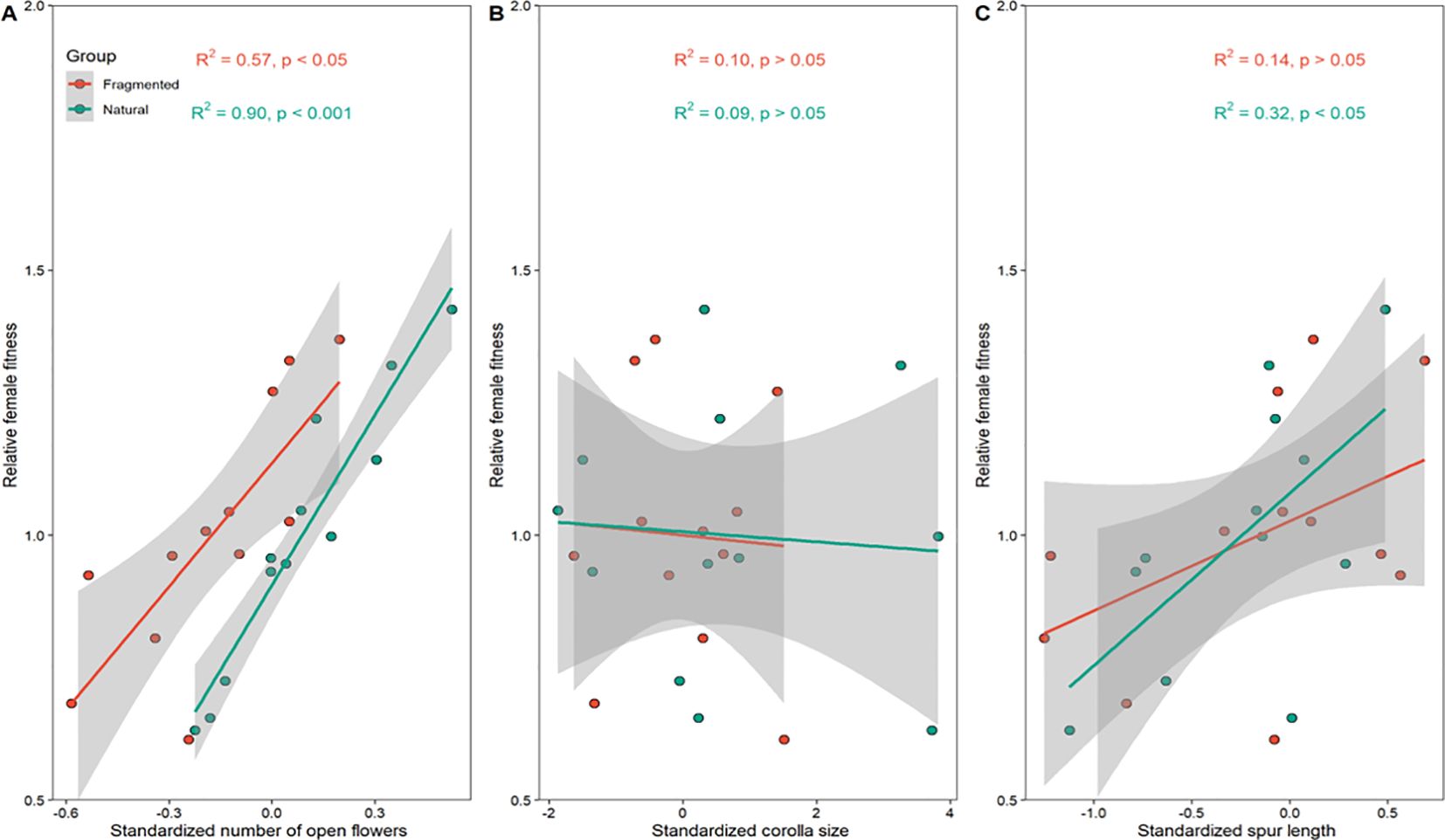
Figure 5. Standardized linear phenotypic selection gradients for (A) number of open flowers, (B) corolla size, and (C) keel petal length within the natural and fragmented habitats.

Table 4. Phenotypic linear selection gradients for plants in natural habitat (βN) and for plants in fragmented habitat (βF) in C. korshinskii.
Our results show that natural selection differed between the natural (βN) and fragmented habitats (βF; Table 4). In the natural habitat, the directional selection for the number of open flowers (βN) was 0.24, while the selection gradient for open flowers in the fragmented habitat was lower (βF = 0.18; Table 4). Moreover, the intensity of directional selection on the number of open flowers and keel petal length in natural habitats was significantly higher than that in fragmented habitats (PDisplay < 0.001; Table 4). In both habitats, our results also showed that habitat type significantly affected linear selection gradients for the number of open flowers (habitat effect, PDisplay × Habitat < 0.05; Table 4).
Effect of pollinator visitation frequency on female fitness in fragmented habitats
During the observation period, Apis mellifera ligustica Spinola was the most frequently observed floral visitor, constituting 81% of the 120 recorded insect visits. Additionally, the list of occasional insect visitors is provided in Supplementary Table S1. We found that C. korshinskii flowers possess a tripping mechanism, with visiting pollinators acting as tripping agents. Pollinators use their bodies to touch the petals, causing the flowers to open earlier. Furthermore, the visitation time of A. mellifera coincided with the observation period.
Pollinator visitation frequency significantly differed between the natural and fragmented habitats (P < 0.05). In both habitats, standardized pollinator visitation frequency was positively correlated with the number of open flowers (R² = 0.91, Natural; R² = 0.92, Fragmented; Figure 6A). In the natural habitat, seed production per selected flower was 4.6, and pollinator visitation frequency was 22.6. Our findings show that relative female fitness was significantly positively correlated with standardized pollinator visitation frequency (R² = 0.85, Natural; R² = 0.63, Fragmented; P < 0.01; Figure 6B).
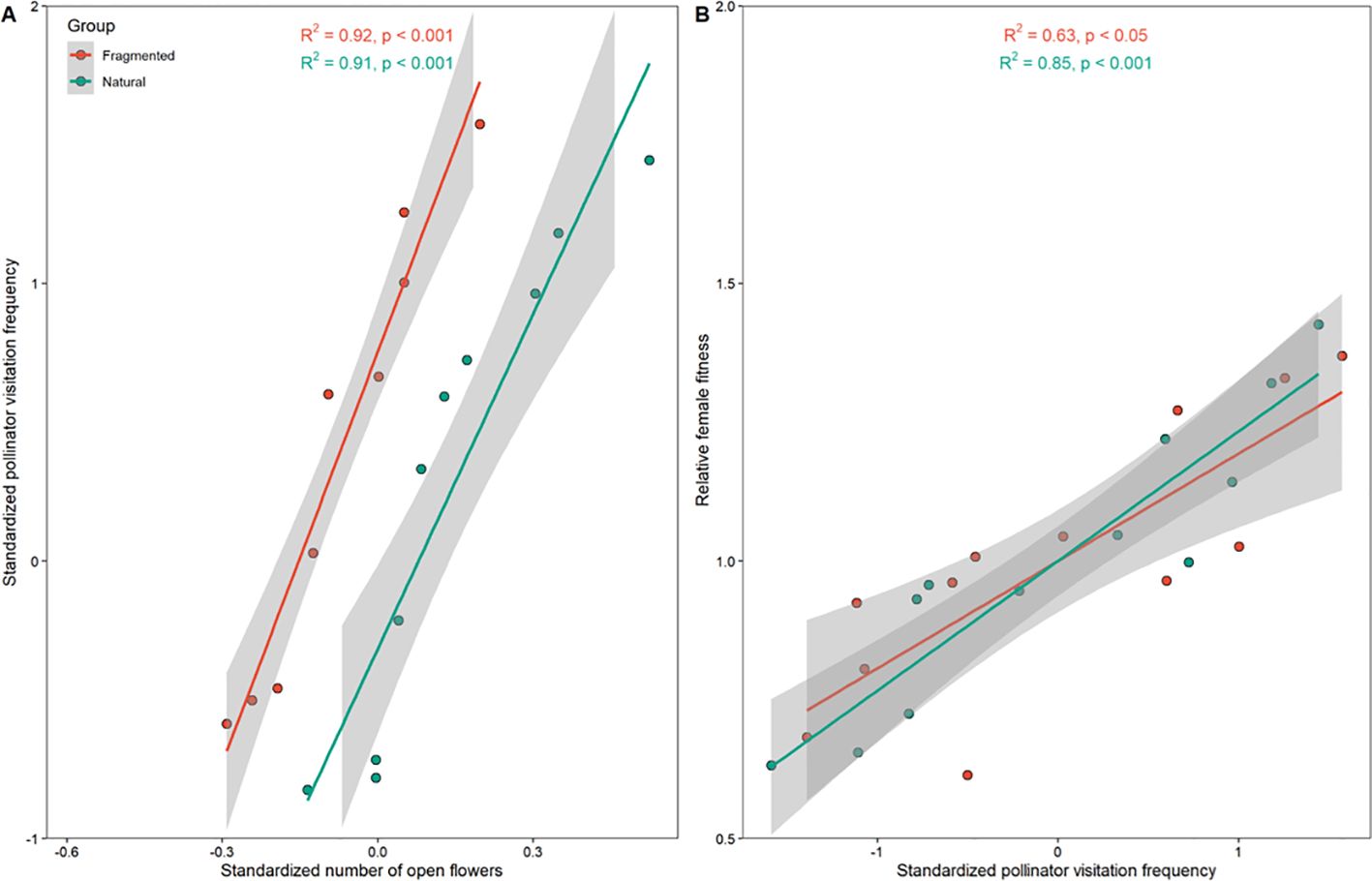
Figure 6. Relationships between number of open flowers (OF) and pollinator visitation frequency (VF) influence female fitness (FF). (A) Relationships between OF and VF, and (B) relationships between VF and FF.
Although the fragmented habitat strongly affected the number of open flowers (OF) and corolla size, SEM results showed that the number of open flowers primarily influenced female fitness through its indirect effect on pollinator visitation frequency (OF → VF, covariance coefficient = 0.72) and direct effect on female fitness (OF → FF, covariance coefficient = 0.37) (Figure 7A). Our results indicate that keel petal length did not directly or significantly affect pollinator visitation frequency or female fitness. Furthermore, the fragmented habitat indirectly affected female fitness by cascading its effects on the number of open flowers, which in turn affected pollinator visitation frequency (VF → FF, covariance coefficient = 0.56). By calculating the total effects of each individual driver on female fitness, our findings suggest that the number of open flowers had the greatest positive and integrated effect on female fitness, followed by pollinator visitation frequency (Figure 7B). Additionally, the fragmented habitat had negative effects on female fitness.
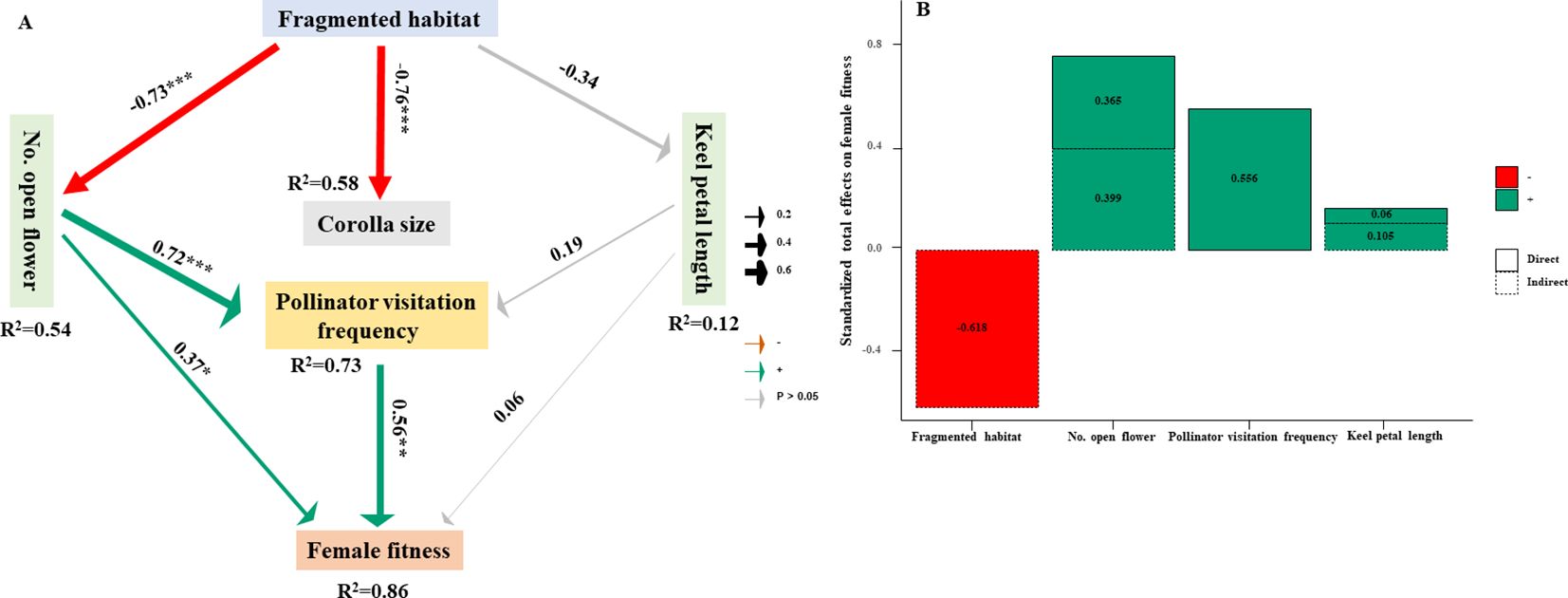
Figure 7. Structural equation modeling that depicts the direct and indirect impacts of fragmented habitat on female fitness. (A) Structural equation modeling revealing the impacts of the OF and VF on female fitness (Fisher’s C= 13.65; P = 0.32; df = 12). The red and green arrows respectively show significant positive and negative effects (P < 0.05), while gray arrows indicate non-significant relationships. The values adjacent to the arrows represent standardized path coefficients. The width of the arrows corresponds to the strength of the path coefficients. R2 donates the proportion of variance explained. Significant levels for each predictor are denoted as *P < 0.05, **P < 0.01, ***P < 0.001. (B) Standardized total effects of all variables on female fitness derived from the SEM depicted above.
Discussion
Study limitations
While this study advances our understanding of pollen limitation dynamics in fragmented habitats, three key methodological considerations warrant explicit discussion to contextualize its contributions. First, although we established correlations between pollinator visitation frequency and female fitness, our experimental design did not incorporate two critical components of pollination efficiency: (1) taxonomic identification of floral visitors, and (2) quantitative pollen transfer metrics (e.g., pollen load quantification on insect vectors or stigma pollen deposition counts). This gap constrains our ability to mechanistically link specific pollinator behaviors, such as interspecific variation in pollen carryover rates to observed differences in floral display selection pressures between habitat types.
Second, although pollen limitation assessments were conducted in both 2021 (pilot phase) and 2023, we strategically focused on 2023 data to minimize confounding effects of interannual environmental variability. While this approach aligns with our core objective of disentangling spatial drivers of pollen limitation, it necessarily excludes temporal dimension analyses. Future longitudinal studies spanning at least five reproductive cycles could elucidate whether the observed patterns represent evolutionarily stable selective regimes or ephemeral ecological responses.
Pollen limitation and pollinators in fragmented habitats
Pollen quantity and quality may decrease due to insufficient pollen delivery or inefficient pollinator visits, leading to pollen limitation (Knight et al., 2005; Ashman et al., 2004). Many flowering plants experience severe pollen limitation due to limited pollen availability and unreliable pollinator visits (Lennartsson, 2002; Nayak and Davidar, 2010). The intensity of pollen limitation is also related to pollinator visitation efficiency, as pollination services are crucial for animal-pollinated plants (Liu et al., 2020). Previous studies indicate that fragmented habitats often reduce pollinator visitation efficiency and disrupt pollination processes (Newman et al., 2013; Chen et al., 2016). In this study, variation in floral displays often translates into differences in female fitness due to its effect on pollinator visitation frequency in fragmented habitats. Our findings show that C. korshinskii experiences more severe pollen limitation in fragmented habitats than in natural habitats, with supplemental hand pollination being the dominant factor influencing female fitness.
Our results demonstrate a positive impact of open flower number on female fitness within fragmented habitats (Figure 7A). This stems from enhanced nectar and pollen availability due to more open flowers, crucial for attracting pollinators. Consequently, optimal floral displays boost pollinator visitation and pollination efficiency (Vaughton and Ramsey, 2010). Moreover, our study indicates that floral resource abundance significantly influences pollinator visitation frequency and female fitness (Figure 5), highlighting the key role of open flower quantity in determining reproductive success for pollinator-dependent plants.
Natural selection on floral display affects reproductive success in fragmented habitats
To understand how fragmented habitats influence floral display evolution, it is essential to quantify them as selective agents (Sletvold et al., 2017). An optimal floral display attracts pollinators and increases visitation frequency, with a positive correlation between flower density and pollinator visits (Ortíz et al., 2010). In fragmented habitats, plants with fewer flowers may experience directional selection, and floral display can reduce pollination efficiency (Kishore et al., 2012; Sletvold et al., 2017). In C. korshinskii, habitat fragmentation influences the selection pressure on the number of open flowers.
Plant–pollinator interactions drive floral diversity, and pollen transfer limits female reproductive success, suggesting that natural selection on floral display is widespread (Ashman and Morgan, 2004). Pollinators typically prefer more open flowers and longer keel petals, with the number of open flowers often setting the upper limit on seed production (Ashman et al., 2004; Gómez, 2003). Many studies show that the number of open flowers influences pollinator visitation and outcrossing rates, leading to higher seed production (Ortíz et al., 2010). In our study, 42% of plants in the natural habitat were strongly selected for more open flowers. In the fragmented habitat, 50% of plants were under directional selection for a greater number of open flowers. Shortening keel petal length significantly reduces female fitness, while longer keel petals enhance pollination efficiency (Sletvold et al., 2017; Gómez, 2003). Additionally, this species exhibits directional selection for longer keel petals, though habitat type does not significantly affect the linear selection gradient for keel petal length. Our study is the first to experimentally quantify the impact of natural selection on floral display in *Caragana* species across different habitats. This study enhances our understanding of how fragmented habitats shape floral display evolution in C. korshinskii.
Many studies have noted a challenge in quantifying natural selection through hand-pollination treatments, particularly in distinguishing the effects of display variation on pollen quality and quantity (Sletvold et al., 2017). In this study, however, the impact of the hand-pollination treatment on pollen quality was minimized. In C. korshinskii, self-pollination efficiency is low. Additionally, hand-pollinated plants received a mixture of pollinator-transferred and hand-supplemented pollen, with minimal differences in pollen quality. Therefore, natural selection on floral display reflects variation in pollen deposition quantity.
Relationships between pollinator visitation and female fitness in fragmented habitats
Plants are immobile and rely on pollinators for pollen transfer, a critical strategy for sexual reproduction (Harder and Aizen, 2010). Pollinator selection of floral display plays a key role in pollen transfer and seed production (Karron and Mitchell, 2012; Gómez, 2003). Over the past two decades, the fragmentation of natural habitats due to urbanization and human disturbance has increased significantly (Delnevo et al., 2019). In fragmented habitats, the spatial distance between animal-pollinated plants increases, while pollinator visit time decreases, resulting in lower pollinator visitation frequency and increased genetic isolation of plants (Newman et al., 2013). Pollinator services primarily depend on visitation efficiency, which is considered a direct causal factor influencing female fitness (Knight et al., 2005; Herrera, 2020). Pollinator visits are positively correlated with flower resource density, and higher visitation frequency can enhance cross-pollen transport (Ortíz et al., 2010). Additionally, habitat fragments increase edge effects on potential pollinator visits, which may prevent or hinder pollinator movement between fragments. In this study, *Apis mellifera* was more common in natural habitats. Moreover, plants in natural habitats exhibited more open flowers than those in fragmented habitats, offering an explanation for the observed difference in female fitness.
Habitat fragmentation is a widespread change in terrestrial ecosystems that profoundly impacts plant-pollinator interactions (Potts et al., 2016). Plant reproductive success significantly affects the population viability and ecological stability of desert steppes (Chen et al., 2022). In desert steppes, pollinator abundance and diversity are declining due to human-related factors such as habitat fragmentation, climate change, and overgrazing (Potts et al., 2016). Habitat change affects biomass allocation to reproductive organs, leading to altered reproductive strategies (Revel et al., 2012). A suitable floral display can enhance pollination services and reproductive success (Sletvold et al., 2017). Previous studies suggest that floral display influences pollinator selection and is linked to habitat loss and climate change (Revel et al., 2012; Delnevo et al., 2019). Similar studies have shown that plants exhibit lower female fitness when pollinator visitation frequency decreases, with visitation linked to reproductive success (Cresswell, 1997; Suzuki, 2000; Jones and Agrawal, 2017). In our study, pollinator visitation frequency positively influenced female fitness, which is considered a key indicator of reproductive success. Most importantly, we found that the number of open flowers, rather than corolla size or keel petal length, was the primary driver influencing the relationship between pollinator visitation frequency and female fitness, with fragmented habitat affecting female fitness through its cascading effects on the number of open flowers. Our study provides strong evidence that the effects of habitat fragmentation cascade through multiple levels, influencing various factors. Most previous studies on floral display-reproduction relationships focus on a single level, whereas this study advances our understanding of the overall effects of habitat fragmentation on female fitness from multiple perspectives. Therefore, this study demonstrates that fragmented habitats affect reproductive success through natural selection on the number of open flowers and pollinator visitation frequency in desert steppes.
Conclusions
We experimentally quantified how fragmented habitats affect floral display and natural selection on pollinator visitation. In C. korshinskii, 42% of plants in the natural habitat were strongly selected for more open flowers (βN = 0.24), and 50% of plants in fragmented habitats showed directional selection for greater numbers of open flowers (βF = 0.18). We conclude that the number of open flowers is the primary selective factor, with fragmented habitats significantly influencing the linear selection gradients for this trait. Additionally, the number of open flowers directly and significantly impacts pollinator visitation frequency and female fitness. Our work provides the first evidence that changes in the number of open flowers in fragmented habitats are a primary driver of floral display-reproduction relationships. This study highlights the need to investigate the interactions between floral display and pollinator visitation in fragmented habitats to better manage pollen limitation and reproductive success in dominant Fabaceae species.
Data availability statement
The raw data supporting the conclusions of this article will be made available by the authors, without undue reservation.
Author contributions
MC: Data curation, Funding acquisition, Methodology, Writing – original draft, Writing – review & editing. Z-j-yW: Methodology, Software, Writing – review & editing. X-jM: Writing – review & editing. X-yZ: Writing – review & editing, Methodology.
Funding
The author(s) declare that financial support was received for the research and/or publication of this article. This work was supported by Major Science and Technology Project of Inner Mongolia Autonomous Region (2024JBGS00130203), West Light Foundation, Chinese Academy of Sciences (E129050301), the science and technology project of China Huaneng Group Co., Ltd. (HNKJ21-H76).
Acknowledgments
M. C. designed this experiment. ZJY. W, XJ. M, and XY. Z contributed significantly to analysis and manuscript preparation. M. C. performed the data analyses and wrote the manuscript. All authors reviewed the manuscript.
Conflict of interest
The authors declare that the research was conducted in the absence of any commercial or financial relationships that could be construed as a potential conflict of interest.
Generative AI statement
The author(s) declare that no Generative AI was used in the creation of this manuscript.
Publisher’s note
All claims expressed in this article are solely those of the authors and do not necessarily represent those of their affiliated organizations, or those of the publisher, the editors and the reviewers. Any product that may be evaluated in this article, or claim that may be made by its manufacturer, is not guaranteed or endorsed by the publisher.
Supplementary material
The Supplementary Material for this article can be found online at: https://www.frontiersin.org/articles/10.3389/fpls.2025.1522871/full#supplementary-material
References
Ashman, T. L., Knight, T. M., Steets, J. A., Amarasekare, P., Burd, M., Campbell, D. R., et al. (2004). Pollen limitation of plant reproduction: ecological and evolutionary causes and consequences. Ecology 85, 2408–2421. doi: 10.1890/03-8024
Ashman, T. L. and Morgan, M. T. (2004). Explaining phenotypic selection on plant attractive characters: male function, gender balance or ecological context? Proc. R. Soc Lon. B 271, 553–559. doi: 10.1098/rspb.2003.2642
Asikainen, E. and Mutikainen, P. (2005). Pollen and resource limitation in a gynodioecious species. Am. J. Bot. 92, 487–494. doi: 10.3732/ajb.92.3.487
Chen, M. and Zhao, X. (2019). Impact of floral characters, pollen limitation, and pollinator visitation on pollination success in different populations of Caragana korshinskii Kom. Sci. Rep. 9, 9741. doi: 10.1038/s41598-019-46271-z
Chen, M., Zhao, X. Y., Yue, P., Guo, X. X., Qiao, J. J., and Li, X. Y. (2022). Effect of grazing disturbance on floral display, pollen limitation and plant pollination efficiency in the desert steppe. BMC Plant Biol. 22, 514. doi: 10.1186/s12870-022-03899-w
Chen, M., Zhao, X. Y., Zuo, X. A., Mao, W., Hao, Q., and Zhu, Y. C. (2016). Effects of habitat disturbance on the pollination system of Ammopiptanthus mongolicus (Maxim) Cheng f. at the landscape-level in an arid region of Northwest China. J. Plant Res. 129, 435–447. doi: 10.1007/s10265-015-0779-7
Chen, M. and Zuo, X. A. (2019). Effect of pollen limitation and pollinator visitation on pollination success of Haloxylon ammodendron (C. A. Mey.) Bunge in fragmented habitats. Front. Plant Sci. 10. doi: 10.3389/fpls.2019.00327
Chen, M., Zuo, X. A., and Zhao, X. Y. (2020). Comparative floral characters, pollinator limitation and pollination success in different habitats of Caragana microphylla Lam. Front. Ecol. Evol. 8. doi: 10.3389/fevo.2020.00170
Corbett, S. A. (2003). Nectar sugar content: estimating standing crop and secretion rate in the field. Apidologie. 34, 1–10. doi: 10.1051/apido:00049
Cresswell, J. E. (1997). Spatial heterogeneity, pollinator behaviour and pollinator-mediated gene flow: Bumblebee movements in variously aggregated rows of oil-seed rape. Oikos 78, 546–556. doi: 10.2307/3545616
Delnevo, N., Van Etten, E. J., Byrne, M., and Stock, W. D. (2019). Floral display and habitat fragmentation: Effects on the reproductive success of the threatened mass-flowering Conospermum undulatum (Proteaceae). Ecol. Evol. 9, 11494–11503. doi: 10.1002/ece3.v9.19
Fernández, J. D., Bosch, J., Nieto-Ariza, B., and Gómez, J. M. (2012). Pollen limitation in a narrow endemic plant: geographical variation and driving factors. Oecologia 170, 421–431. doi: 10.1007/s00442-012-2312-1
Gigord, L. D. B., Macnair, M. R., and Smithson, A. (2001). Negative frequency-dependent selection maintains a dramatic flower color polymorphism in the rewardless orchid Dactylorhiza sambucina (L.) Soo. Proc. Natl. Acad. Sci. U.S.A. 98, 6253–6255. doi: 10.1073/pnas.111162598
Gómez, J. M. (2003). Herbivory reduces the strength of pollinator-mediated selection in the Mediterranean herb Erysimum mediohispanicum: Consequences for plant specialization. Am. Nat. 162, 242–256. doi: 10.1086/376574
Gómez, J. M., Abdelaziz, M., Lorite, J., Munõz-Pajares, A. J., and Perfectti, F. (2010). Changes in pollinator fauna cause spatial variation in pollen limitation. J. Ecol. 98, 1243–1252. doi: 10.1111/j.1365-2745.2010.01691.x
Guo, Z., Chang, H. T., and Liu, R. T. (2022). Response of soil microarthropod community to seasonal changes in urat desert steppe, inner Mongolia. Front. Environ. Sci. 10. doi: 10.3389/fenvs.2022.893913
Hadley, A. S. and Betts, M. G. (2012). The effects of landscape fragmentation on pollination dynamics: absence of evidence not evidence of absence. Biol. Rev. 87, 526–544. doi: 10.1111/j.1469-185X.2011.00205.x
Harder, L. D. and Aizen, M. A. (2010). Floral adaptation and diversification under pollen limitation. Philos. T. R. Soc B 365, 529–543. doi: 10.1098/rstb.2009.0226
Herrera, C. M. (2020). Flower traits, habitat, and phylogeny as predictors of pollinator service: A plant community perspective. Ecol. Monogr. 90, 1402. doi: 10.1002/ecm.1402
Hu, Z. K., Delgado-Baquerizo, M., Fanin, N., Chen, X. Y., Zhou, Y., Du, G. Z., et al. (2024). Nutrient-induced acidification modulates soil biodiversity-function relationships. Nat. Commun. 15, 2858. doi: 10.1038/s41467-024-47323-3
Ishii, J. and Kadono, Y. (2002). Factors influencing seed production of Phragmites australis. Aquat. Bot. 72, 129–141. doi: 10.1016/S0304-3770(01)00218-2
Jones, P. L. and Agrawal, A. A. (2017). Learning in insect pollinators and herbivores. Annu. Rev. Entomol. 62, 53–71. doi: 10.1146/annurev-ento-031616-034903
Karron, J. D. and Mitchell, R. J. (2012). Effects of floral display size on male and female reproductive success in Mimulus ringens. Ann. Bot-London. 109, 563–570. doi: 10.1093/aob/mcr193
Kishore, K., Shukla, A. K., Babu, N., Sarangi, D. N., and Patanayak, S. (2012). Pollination biology of Annona squamosa L. (Annonaceae): Evidence for pollination syndrome. Sci. Hortic-Amsterdam. 144, 212–217. doi: 10.1016/j.scienta.2012.07.004
Knight, T. M., Steets, J. A., Vamosi, J. C., Mazer, S. J., Burd, M., Campbell, D. R., et al. (2005). Pollen limitation of plant reproduction: pattern and process. Annu. Rev. Ecol. Evol. Syst. 36, 467–497. doi: 10.1146/annurev.ecolsys.36.102403.115320
Lefcheck, J. S. (2016). piecewiseSEM: Piecewise structural equation modelling in R for ecology, evolution, and systematics. Methods Ecol. Evol. 7, 573–579. doi: 10.1111/mee3.2016.7.issue-5
Lennartsson, T. (2002). Extinction thresholds and disrupted plant-pollinator interactions in fragmented plant populations. Ecology 83, 3060–3072.
Liu, R. R., Chen, D. L., Luo, S. D., Xu, S. J., Xu, H. L., Shi, X. Y., et al. (2020). Quantifying pollination efficiency of flower-visiting insects and its application in estimating pollination services for common buckwheat. Agric. Ecosystems Environment. 301, 107011. doi: 10.1016/j.agee.2020.107011
Nayak, K. G. and Davidar, P. (2010). Pollinator limitation and the effect of breeding systems on plant reproduction in forest fragments. Acta Oecol. 36, 191–196. doi: 10.1016/j.actao.2009.12.004
Newman, B. J., Ladd, P., Brundrett, M., and Dixon, W. K. (2013). Effects of habitat fragmentation on plant reproductive success and population viability at the landscape and habitat scale. Biol. Conserv. 159, 16–23. doi: 10.1016/j.biocon.2012.10.009
Ortíz, F. E., Stoner, K., Pérez-Negrón, E., and Casas, A. (2010). Pollination biology of Myrtillocactus schenckii (Cactaceae) in wild and managed populations of the Tehuacán Valley, México. J. Arid. Environ. 74, 897–904. doi: 10.1016/j.jaridenv.2010.01.009
Potts, S. G., Imperatriz-Fonseca, V., Ngo, H. T., Aizen, M. A., Biesmeijer, J. C., Breeze, T. D., et al. (2016). Safeguarding pollinators and their values to human well-being. Nature 540, 220–229. doi: 10.1038/nature20588
Revel, N., Alvarez, N., Gibernau, M., and Anahí, E. (2012). Investigating the relationship between pollination strategies and the size-advantage model in zoophilous plants using the reproductive biology of Arum cylindraceum and other European Arum species as case studies. Arthropod-Plant Interact. 6, 35–44. doi: 10.1007/s11829-011-9164-1
Sletvold, N. and Ågren, J. (2010). Pollinator-mediated selection on floral display and spur length in the orchid Gymnadenia conopsea. Int. J. Plant Sci. 171, 999–1009. doi: 10.1086/656597
Sletvold, N., Grindeland, J. M., and Ågren, J. (2010). Pollinator-mediated selection on floral display, spur length and flowering phenology in the deceptive orchid Dactylorhiza lapponica. New Phytol. 188, 385–392. doi: 10.1111/j.1469-8137.2010.03296.x
Sletvold, N., Tye, M., and Ågren, J. (2017). Resource- and pollinator-mediated selection on floral traits. Funct. Ecol. 31, 135–141. doi: 10.1111/fec.2017.31.issue-1
Steffan-Dewenter, I., Klein, A. M., Gaebele, V., Alfert, T., and Tscharntke, T. (2006). “Bee diversity and plant-pollinator interactions in fragmented landscapes,” in Plant-pollinator interactions: from specialization to generalization. Eds. Waser, N. M. and Ollerton, J. (Chicago: University of Chicago Press), 387–407.
Sun, H. Q., Huang, B. Q., Yu, X. H., Tian, C. B., Peng, Q. X., and An, D. J. (2018). Pollen limitation, reproductive success and flowering frequency in single-flowered plants. J. Ecol. 106, 19–20. doi: 10.1111/1365-2745.12834
Suzuki, N. (2000). Pollinator limitation and resource limitation of seed production in the Scotch broom, Cytisus scoparius (Leguminosae). Plant Spec. Biol. 15, 187–193. doi: 10.1046/j.1442-1984.2000.00038.x
Vaughton, G. and Ramsey, M. (2010). Floral emasculation reveals pollen quality limitation of seed output in Bulbine bulbosa (Asphodelaceae). Am. J. Bot. 97, 174–178. doi: 10.3732/ajb.0900183
Villagra, P. E., Defossé, G. E., Del Valle, H. F., Tabeni, S., Rostagno, M., Cesca, E., et al. (2009). Land use and disturbance effects on the dynamics of natural ecosystems of the Monte Desert: implications for their management. J. Arid Environ. 73, 202–211. doi: 10.1016/j.jaridenv.2008.08.002
Wang, G. H., Chen, Z. X., Yang, X. L., Cai, G. J., and Shen, Y. Y. (2022). Effect of simulated precipitation regimes on sap flow and water use efficiency for xerophytic Caragana korshinskii. Ecol. Indic. 143, 109309. doi: 10.1016/j.ecolind.2022.109309
Yao, Y., Shao, M., Fu, X., Wang, X., and Wei, X. (2019). Effects of shrubs on soil nutrients and enzymatic activities over a 0–100 cm soil profile in the desert-loess transition zone. Catena 174, 362–370. doi: 10.1016/j.catena.2018.11.031
Keywords: fragmented habitat, floral display, pollen limitation, female fitness, pollinator visitation frequency
Citation: Chen M, Wang Z-j-y, Ma X-j and Zhao X-y (2025) Impact of fragmented habitats on reproductive success in dominant shrubs: natural selection on floral display and pollinator visitation. Front. Plant Sci. 16:1522871. doi: 10.3389/fpls.2025.1522871
Received: 05 November 2024; Accepted: 19 May 2025;
Published: 05 June 2025.
Edited by:
Monika M. Lipińska, University of Gdansk, PolandReviewed by:
Abelardo Carlos Vegetti, CONICET Santa Fe, ArgentinaBalkrishna Ghimire, Agriculture and Forestry University, Nepal
Copyright © 2025 Chen, Wang, Ma and Zhao. This is an open-access article distributed under the terms of the Creative Commons Attribution License (CC BY). The use, distribution or reproduction in other forums is permitted, provided the original author(s) and the copyright owner(s) are credited and that the original publication in this journal is cited, in accordance with accepted academic practice. No use, distribution or reproduction is permitted which does not comply with these terms.
*Correspondence: Min Chen, Y2hlbm1pbjEzNjBAMTI2LmNvbQ==; Y2hlbm1AbHpiLmFjLmNu
 Min Chen
Min Chen Zheng-jiao-yi Wang1,2,4
Zheng-jiao-yi Wang1,2,4 Xu-jun Ma
Xu-jun Ma Xue-yong Zhao
Xue-yong Zhao